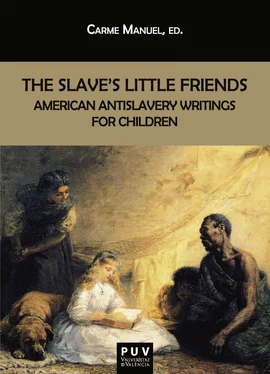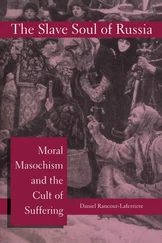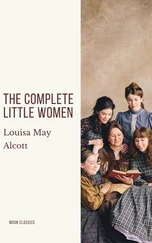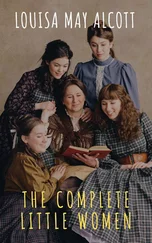“Old Betty” was first recognized to be “one of the earliest American antislavery children’s stories known to exist” by Teute in her 1996 article “In ‘the gloom of evening’: Margaret Bayard Smith’s View in Black and White of Early Washington Society.” Teute discovered the piece in the American Antiquarian Society in 1994. The tale tells the story of “a homeless old slave wandering in the countryside on the outskirts of Washington near where the Seymour family lived” (1996: 40). It is “an old black woman’s tale of profound racial alienation and hatred […] resolved through Christian redemption” (2001: 218). In a letter dated November 26, 1824, Smith’s friend Eliza Quincy, a member of an important political family in Boston, praised the story: “There is no doubt a wide field for original and affecting description on the subjects of slaves, and slavery. Humanity and religion call for attention to their cause, and relief. It is a very difficult question, in the present situation of the slave holding states to say, how, or what can be effected, in a general way—but nothing but good can be the result of an appeal in their behalf for kinder treatment, and better instruction” (Teute 1996: 40).
The story starts with a seemingly idyllic scene of domestic happiness in the Seymour family where daughters Louisa and Matilda play with their slave companion Matty, under the care of Mrs. Seymour, who, following the principles of Republican motherhood, guards the moral growth of their daughters and little servant. When Old Betty arrives in the evening, she is encouraged to tell them her story of hard work and miseries. Betty’s body has been devastated by a life of hardships and physical tortures and she can barely walk. When invited to eat some food, she reminds them that the only food that really matters is the spiritual treasures dispensed by Jesus. At this turning point in the narrative, the black slave appropriates the teachings of white Christianity and empowers herself as a prophetess imparting Biblical wisdom to her hostesses. She then goes on to narrate how she fell in love with a slave in her plantation and how their master and mistress reject their wish to get married. Betty disobeys their orders and is consequently sold to a Georgian plantation. On board a vessel, her despair for the separation makes her forget her little baby, who dies and she tries to commit suicide, but is finally saved, and then sold to a benevolent family. In her new home she takes care of their young daughter. The girl is an angelical creature who teaches her the Bible and, as a sort of predecessor of Uncle Tom ’s Eva, dies happy to welcome death and meet her Savior.
Old Betty is presented as a preacher of moral truths, even if those values act against the freedom of the enslaved. In fact, when she arrives at the Seymours’ house, her life story acts as a shadowy reminder of the fate that awaits other black enslaved women in the home. The family owns Matty, who even if treated kindly by Mrs. Seymour, is vulnerable to a tragic denouement: “Matty, who was only two years older than Louisa, had been so entirely their companion, and so carefully brought up, that she had caught their language and ideas, and though a slave , looked upon Mrs. Seymour more as a mother than a mistress: but this could not last, the age for labour was drawing on, when, instead of being the playmate, she was to become the servant of the young ladies, but always a favoured one.” Thus, the story starts with an ominous warning about the fragility of black women slaves in the slavery system. Matty’s future might resemble Old Betty’s miserable life story.
For Teute, American Mother is beneath the surface “much more than a children’s book” (1996: 46). But, far from being what she calls “a subversive text” that “rejects, questions, or undermines hierarchical relations between men and women, master and servants, whites and blacks” (1996: 46), “Old Betty” shows empathy towards the old black slave insofar as she is willing to recognize her attempts at freedom as moral failings. Hers becomes then a cautionary tale for black women. Yet, Smith’s story is valuable as an early attempt to provide a tale of slavery from the point of view of a dignified black woman.
SCENES IN GEORGIA(1827) by Isabel Drysdale, a small volume written for the American Sunday School Union, published in Philadelphia, includes three texts: “The Fisherman of the Solitary Island,” “The Negro Nurse,” and “The Two Cousins; or, the Example and the Warning.” The American Sunday School Union was a movement that had started in England in 1780 with Robert Raikes’s reform efforts in prisons and his teaching enterprises for the children of the working classes derived from the Industrial Revolution, and had won the support of reformers such as William Wilberforce, John Wesley, and George Fox. In the United States, as Anne Boylan explains, the Sunday School movement was part of the general impulse of nineteenth-century evangelical Protestantism, “firmly allied with the new middle-class vision of an expanding free labor economy and a democratic state” (3), that confidently believed in the power of these initiatives to foster such values as “self-control, delayed gratification, and self-improvement,” all of which were part and parcel of the new concept of American liberal citizenship. Founded in Philadelphia in 1824, the American Sunday School Union had as its aim the creation of Sunday schools, and the teaching of literacy and moral guidance of children. To that end, it became one of the most important publishers of children’s books and periodicals, whenever possible freely, throughout the nineteenth century—texts that tried to shape the spiritual life of American children.
For Deborah C. De Rosa, Isabel Drysdale was one of the earliest American domestic abolitionists, and the American Sunday School Union, which never took a radical stand against slavery for fear of offending its readership, might have accepted her tale because she “demands neither colonization nor immediate abolition; rather she shows Northern and Southern children that slaves could attain ‘freedom’ through religious conversion. Through her protagonist, Drysdale suggests that slavery’s worst evil stems not from how it deprives personal freedom but from how it threatens religion” (2003: 16). The narrative tells the story of Old Chloe, a “humble ‘Negro Nurse,’” who as the narrator declares, is “a member of almost every domestic establishment of the south.” Drysdale seems to have taken into account children’s familiarity with the literary character of the mammy (Wallace-Sanders 18). Old Chloe is a sixty-year-old African, whose “sawed teeth and curiously branded cheek, bespeak her a native of Africa; but her easy and contented demeanor, shows that she has long since forgotten the land of her freedom, and found in the ‘white man’s country,’ along with toil and privation, those good lenitives which our kind Father in Heaven has prepared for the heavy laden.” Hence, Old Chloe has become reconciled to her enslavement when, after forty years in the country in a state of spiritual darkness, she is given religious instruction by the girl Frances, another predecessor of Uncle Tom ’s Little Eva. Confronted with sickness and feeling “the woeful evil of her condition,” Old Chloe embraces God (“her stupid apathy to eternal things disappeared”) and recognizes the superiority of Christian spirituality. In fact, for Kimberley Wallace-Sanders, the trait that characterizes this black woman is “the affecting tenderness displayed by the negro nurse to her little charge,” which “seems even to exceed the force of natural affection for her own offspring, combining strong maternal love with the enthusiastic devotedness of loyalty” (18).
Читать дальше












